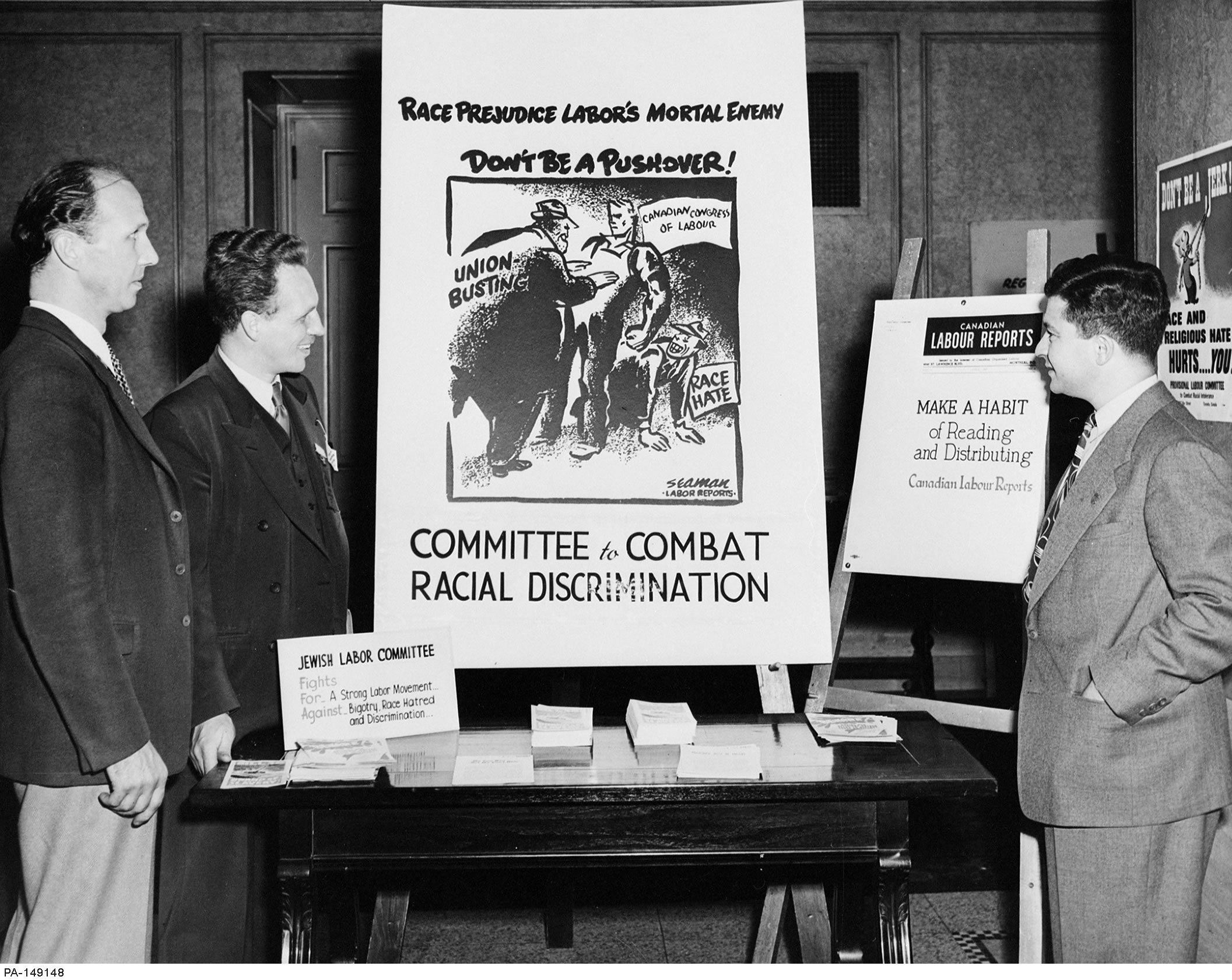Human Rights Activism
| Copyright Dominique Clément / Clément Consulting
The Padlock Act spurred the formation of the first rights associations in Canada. Several branches of an organization called the Canadian Civil Liberties Union (CCLU) were formed across the country, and each one campaigned for the repeal of the act. Rights associations such as the CCLU were dedicated to the preservation of rights irrespective of class, beliefs, or background. Fervently non-partisan, they were solely concerned with defending traditional British liberties against state abuse.
Another critical moment was the Gouzenko Affair (1946), which led to the largest mobilization of civil liberties groups in Canadian history at that time. When a royal commission was set up to interrogate suspected communist spies, two new civil liberties groups were established in response. The Ottawa Civil Liberties Association (OCLA) was formed in 1946 with the support of such notable figures as Liberal senator Arthur Roebuck and Canada’s first female senator, Cairine Wilson. Originally, the group hoped to incorporate both social democrats and communists, but its significant ideological divisions soon became apparent. Another organization was formed in Toronto, the Emergency Committee for Civil Rights (ECCR), which was soon renamed the Civil Rights Union. The ECCR had broken away from the other Toronto group, the Civil Liberties Association of Toronto, reflecting once again the ideological divisions that plagued the left. Members of the ECCR included C.S. Jackson, a communist and leader of the United Electrical Workers. Another body, the Montreal Civil Liberties Association, led by Frank Scott, also emerged at about the same time. By 1946, there were six civil liberties groups in Canada.
Rights associations paid for advertisements in the Montreal Star and the Toronto Star, two of Canada’s leading papers, condemning Order-in-Council PC6444 and the use of emergency powers (War Measures Act). Associations in Ottawa and Winnipeg introduced resolutions and organized letter-writing campaigns to the minister of justice, demanding that the government stop distributing the espionage commission’s report. The report accused several individuals of having violated the Official Secrets Act, though they had not been tried in court. B.K. Sandwell of the Civil Liberties Association of Toronto attacked the commission in the popular magazine he edited, Saturday Night, and Arthur Lower of the Manitoba Civil Liberties Association expressed similar concerns in the pages of the Winnipeg Free Press. Several groups had their resolutions quoted before Parliament. The most active were unquestionably the Ottawa Civil Liberties Association and the Civil Rights Union. Both produced detailed reports on the commission, covering its various abuses and the conditions of the suspects’ imprisonment with impressive detail.
Rights associations operated on shoestring budgets and depended on volunteer work and individual donations or the sponsorship of wealthy patrons. They were beset by ideological divisions between communists and social democrats. In Toronto, the antipathy between the two groups was strong enough to require the formation of two separate organizations (the Association for Civil Liberties and the communist-led Civil Rights Union). The Civil Liberties Association of Winnipeg refused to allow known communists to join, and the Ottawa Civil Liberties Association disbanded largely as a result of ideological conflicts among its members.
Ideological divisions also contributed to the failure to form a national organization. In 1941, the Montreal branch of the Canadian Civil Liberties Union attempted to establish a federation of rights associations, only to be rebuffed by those who refused to work with communists. A second attempt in Ottawa to form a national civil liberties body in 1946 failed due to bitter debates among communists and liberals (allied with social democrats). C.S. Jackson of the communist-led Civil Rights Union in Toronto called for a broad-based group to include organized labour, whereas J.P. Erichsen-Brown of the Ottawa Civil Liberties Association rejected the idea of a communist being a legitimate civil libertarian. Rights activists in Toronto formed two separate national organizations, the Association for Civil Liberties and the League for Democratic Rights.
By the 1950s, most of the rights associations that had emerged since the 1930s were largely inactive or defunct. The Association for Civil Liberties and the League for Democratic Rights did not last long. Although the latter could boast of chapters in more than a dozen cities across the country, it was soon moribund. Both groups were also centred in Toronto, and their inability to work cooperatively highlighted the ideological divisions of the period. Members of the Association for Civil Liberties were predominantly left-leaning liberals and social democrats, including Saturday Night editor B.K. Sandwell and Charles Millard (of the United Steelworkers of America). In contrast, the League for Democratic Rights was headed by such figures as C.S. Jackson of the communist-led United Electrical Workers and C.B. Macpherson, a Marxist professor at the University of Toronto. By the end of the 1950s, both groups were inactive.
 Site Resources
Site ResourcesThe readings lists available on this site deal with a range of topics from human rights to biographies and specific events.
-
- Any use of material or referencing content from HistoryOfRights.ca should be acknowledged by the User and cited as follows:
–
- Clément, Dominique. “page title or document title.” Canada’s Human Rights History. www.HistoryOfRights.ca (date accessed).


 History
History 
 © 2024 COPYRIGHT CLÉMENT CONSULTING. ALL RIGHTS RESERVED.
DEPARTMENT OF SOCIOLOGY, UNIVERSITY OF ALBERTA
© 2024 COPYRIGHT CLÉMENT CONSULTING. ALL RIGHTS RESERVED.
DEPARTMENT OF SOCIOLOGY, UNIVERSITY OF ALBERTA